Bavaria train crash: what we know so far
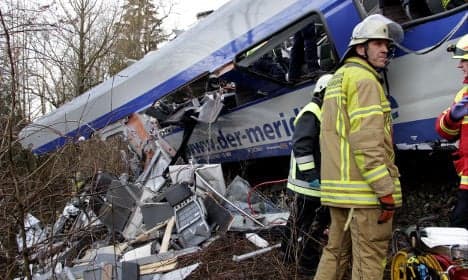
Check here for a quick overview of all the latest information on the train accident in Bad Aibling, Bavaria on Tuesday morning.
The two trains, local commuter services operated by a company called Meridian, collided at around 6:50 on Tuesday morning just outside Bad Aibling, approximately 60 kilometres south-east of Munich.
Ten people were confirmed dead as of Wednesday morning by police, with all missing persons now accounted for.
Around 80 people have been injured, including ten very critical, eight serious and more than 63 light injuries. Bavarian interior minister Joachim Herrmann spoke of rescuers having to deal with "unbelievable injuries" and needing psychological counselling after helping in the accident.
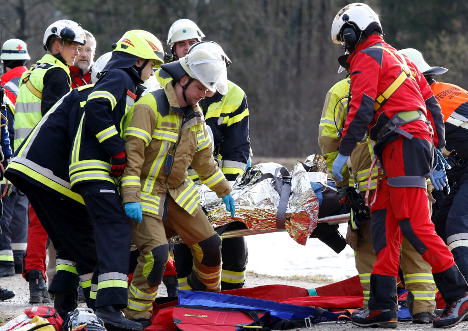 Rescue workers carry a stretcher towards an ambulance following the train crash in Bad Aibling on February 9th. Photo: DPA
Rescue workers carry a stretcher towards an ambulance following the train crash in Bad Aibling on February 9th. Photo: DPA
Fortunately, there were few of the children and young people who might ordinarily have been on the trains this week, because of the Fasching carnival holiday.
More than 500 people were involved in the rescue, including police, firefighters, ambulance crews and water- and mountain-rescue units. Some helpers came from neighbouring Austria to join the mission.
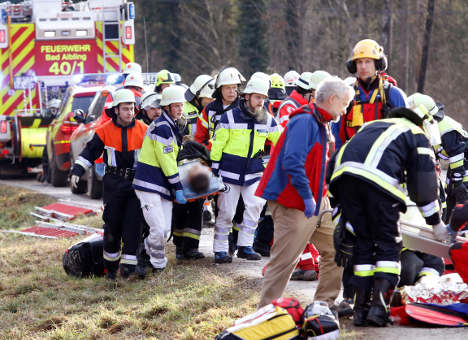 Large numbers of rescue workers are seen with emergency vehicles following the train crash in Bad Aibling on Tuesday February 9th. Photo: DPA
Large numbers of rescue workers are seen with emergency vehicles following the train crash in Bad Aibling on Tuesday February 9th. Photo: DPA
Ten rescue helicopters were on the scene, along with several more from the Bavarian and federal police.
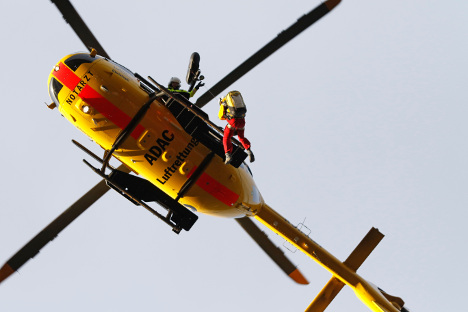 A rescue helicopter from the German Automobile Association (ADAC) lowers a medic on a winch. Photo: DPA
A rescue helicopter from the German Automobile Association (ADAC) lowers a medic on a winch. Photo: DPA
The choppers were used to move the dead and seriously injured from the crash site, which was located in a wooded area by a river and inaccessible to ambulances.
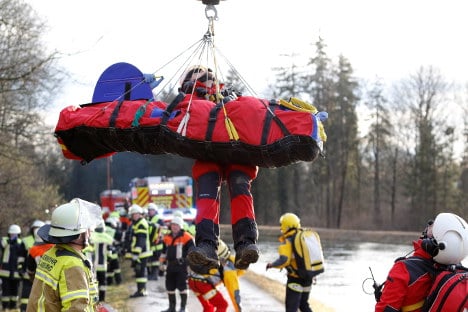 An injured train passenger is winched up towards a helicopter by rescue workers following the train crash in Bad Aibling on February 9th. Photo: DPA
An injured train passenger is winched up towards a helicopter by rescue workers following the train crash in Bad Aibling on February 9th. Photo: DPA
Emergency crews have recovered two of the total of three black boxes from the trains. A third is expected to be recovered over the course of the day. That will allow workers from the Federal Railway Authority and state prosecutors to begin investigating the cause of the crash.
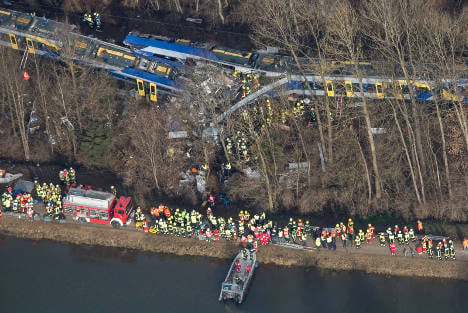 An aerial view of the crash site of two trains in Bad Aibling, Bavaria on February 9th, showing the curvature of the track. Photo: DPA
An aerial view of the crash site of two trains in Bad Aibling, Bavaria on February 9th, showing the curvature of the track. Photo: DPA
The stretch of track where the crash occurred was a curved, single-track section. It's unlikely the two drivers would have seen each other and had time to brake until just before the impact. Each train may have been travelling at up to 100km/h, transport minister Alexander Dobrindt said at a press conference.
But like most railway lines in Germany, the route is fitted with a PZB 90 system which is supposed to automatically activate passing trains' brakes if there is danger of a collision.
A Deutsche Bahn spokesman said on Tuesday that the system on this stretch of track had its last maintenance check around a week ago and no problems were found.
 Trackside transmitters like this one are supposed to automatically brake trains fitted with the PZB 90 system to avoid collisions. Photo: DPA
Trackside transmitters like this one are supposed to automatically brake trains fitted with the PZB 90 system to avoid collisions. Photo: DPA
The system was fitted nationwide following an accident in Magdeburg in January 2011, when 10 people died in a train collision.
The Austrian state of Tirol has said that it would not send a group of 750 refugees to Bavaria who had been scheduled to travel on Tuesday, given the train crash's burden on the authorities.
SEE ALSO: Live updates: Nine dead, 150 injured in train crash near Munich
Comments
See Also
The two trains, local commuter services operated by a company called Meridian, collided at around 6:50 on Tuesday morning just outside Bad Aibling, approximately 60 kilometres south-east of Munich.
Ten people were confirmed dead as of Wednesday morning by police, with all missing persons now accounted for.
Around 80 people have been injured, including ten very critical, eight serious and more than 63 light injuries. Bavarian interior minister Joachim Herrmann spoke of rescuers having to deal with "unbelievable injuries" and needing psychological counselling after helping in the accident.
 Rescue workers carry a stretcher towards an ambulance following the train crash in Bad Aibling on February 9th. Photo: DPA
Rescue workers carry a stretcher towards an ambulance following the train crash in Bad Aibling on February 9th. Photo: DPA
Fortunately, there were few of the children and young people who might ordinarily have been on the trains this week, because of the Fasching carnival holiday.
More than 500 people were involved in the rescue, including police, firefighters, ambulance crews and water- and mountain-rescue units. Some helpers came from neighbouring Austria to join the mission.
 Large numbers of rescue workers are seen with emergency vehicles following the train crash in Bad Aibling on Tuesday February 9th. Photo: DPA
Large numbers of rescue workers are seen with emergency vehicles following the train crash in Bad Aibling on Tuesday February 9th. Photo: DPA
Ten rescue helicopters were on the scene, along with several more from the Bavarian and federal police.
 A rescue helicopter from the German Automobile Association (ADAC) lowers a medic on a winch. Photo: DPA
A rescue helicopter from the German Automobile Association (ADAC) lowers a medic on a winch. Photo: DPA
The choppers were used to move the dead and seriously injured from the crash site, which was located in a wooded area by a river and inaccessible to ambulances.
 An injured train passenger is winched up towards a helicopter by rescue workers following the train crash in Bad Aibling on February 9th. Photo: DPA
An injured train passenger is winched up towards a helicopter by rescue workers following the train crash in Bad Aibling on February 9th. Photo: DPA
Emergency crews have recovered two of the total of three black boxes from the trains. A third is expected to be recovered over the course of the day. That will allow workers from the Federal Railway Authority and state prosecutors to begin investigating the cause of the crash.
 An aerial view of the crash site of two trains in Bad Aibling, Bavaria on February 9th, showing the curvature of the track. Photo: DPA
An aerial view of the crash site of two trains in Bad Aibling, Bavaria on February 9th, showing the curvature of the track. Photo: DPA
The stretch of track where the crash occurred was a curved, single-track section. It's unlikely the two drivers would have seen each other and had time to brake until just before the impact. Each train may have been travelling at up to 100km/h, transport minister Alexander Dobrindt said at a press conference.
But like most railway lines in Germany, the route is fitted with a PZB 90 system which is supposed to automatically activate passing trains' brakes if there is danger of a collision.
A Deutsche Bahn spokesman said on Tuesday that the system on this stretch of track had its last maintenance check around a week ago and no problems were found.
 Trackside transmitters like this one are supposed to automatically brake trains fitted with the PZB 90 system to avoid collisions. Photo: DPA
Trackside transmitters like this one are supposed to automatically brake trains fitted with the PZB 90 system to avoid collisions. Photo: DPA
The system was fitted nationwide following an accident in Magdeburg in January 2011, when 10 people died in a train collision.
The Austrian state of Tirol has said that it would not send a group of 750 refugees to Bavaria who had been scheduled to travel on Tuesday, given the train crash's burden on the authorities.
SEE ALSO: Live updates: Nine dead, 150 injured in train crash near Munich
Join the conversation in our comments section below. Share your own views and experience and if you have a question or suggestion for our journalists then email us at [email protected].
Please keep comments civil, constructive and on topic – and make sure to read our terms of use before getting involved.
Please log in here to leave a comment.